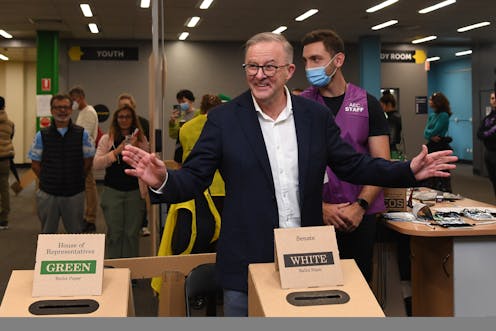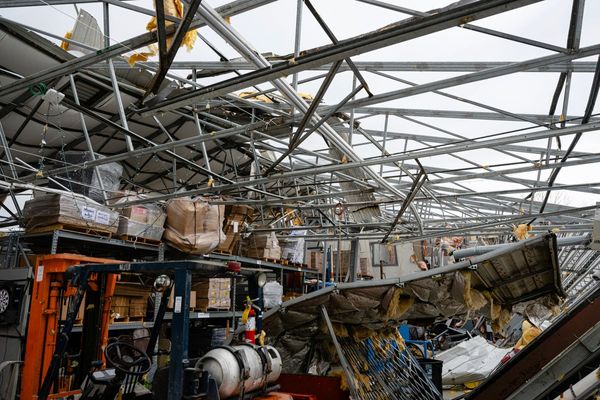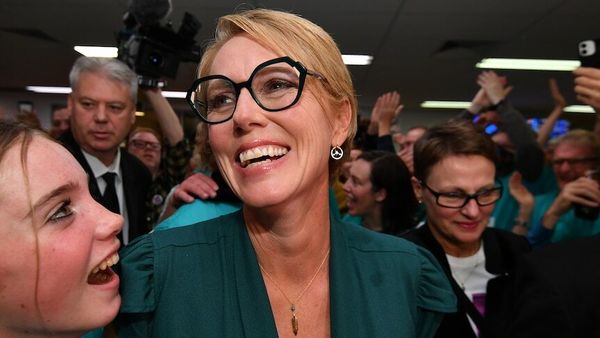
This article was updated on Sunday morning.
With 53% counted at Saturday’s federal election, the ABC is calling 72 of the 151 House of Representatives seats for Labor, 52 for the Coalition, two Greens and nine Others. 16 seats remain in doubt.
Primary votes were 35.3% Coalition (down 6.2% since the 2019 election), 31.9% Labor (down 1.4%), 12.4% Greens (up 2.0%), 5.1% One Nation (up 2.0%), 4.4% UAP (up 1.0%) and 10.9% for all Others (up 2.6%). Labor is projected to win the two party vote by a 51.2-48.8 margin, a 2.7% swing to Labor.
The Poll Bludger’s model has 69 Labor wins to 47 for the Coalition. When seats where a party is ahead are assigned, Labor has 77, the Coalition 60, independents 10 and Greens three. That would put Labor just above the 76 needed for an outright majority. The Poll Bludger’s two party projection is 52.3-47.7 to Labor.
If Labor wins a majority, they can thank WA. Usually one of the most anti-Labor states at federal elections, the Poll Bludger currently has a 55.2-44.8 Labor two party win there, a 9.8% swing to Labor. Labor is ahead in ten WA seats to four for the Liberals with one independent.
In inner city seats, the Liberals will likely lose Treasurer Josh Frydenberg’s Kooyong (Vic), Goldstein (Vic), Higgins (Vic), North Sydney (NSW), Wentworth (NSW), Ryan (Qld) and Brisbane (Qld). However, Higgins was the only clear Labor gain, with the rest either going to independents or the Greens. Labor has likely lost Griffith to the Greens and Kristina Keneally’s Fowler to an independent.
I will have more tomorrow morning about the Senate and close House contests.
The results are an indictment on both major parties. Owing to the education divide, the Coalition lost support in wealthy urban seats, but it was the Greens and independents who gained, not Labor. The Coalition probably lost these seats owing to Scott Morrison’s record on climate change, and because of increasing education polarisation.
Read more: Will a continuing education divide eventually favour Labor electorally due to our big cities?
Inflation is another key reason the Coalition lost this election. The 12-month inflation rate to the March quarter of 5.1% combined with the 2.4% rise in nominal wages meant that real wages fell 2.7% in those 12 months, and were down 2.2% since the 2019 election.
Read more: Newspoll and Ipsos both give Labor clear leads in final polls; counting of early votes
Without this large fall in real wages, the Coalition would have been likely to offset losses in wealthy urban seats with gains from Labor in regional and outer suburban seats. It’s an indictment on Labor that voters didn’t turn to it.
The final two party vote will not be available for weeks as the electoral commission will not start a two party count in seats that were not contests between Labor and the Coalition until the main business of deciding elected members is over.
But with both major parties slumping, the best final pollster of the election was the Resolve poll for Nine newspapers that had primary votes of 34% Coalition, 31% Labor, 14% Greens, 6% One Nation, 4% UAP, 6% independents and 4% others.
Read more: Labor's lead narrows in three new national polls; and seat polls galore
Currently doubtful seats
With 66% counted, the ABC has Labor winning 72 of the 151 seats, the Coalition 50, Others 15 and there are 14 in doubt. In Bass, Casey, Dickson, Menzies and Moore, the Coalition is already ahead and is expected to extend their leads after postals are counted.
In Bennelong, Deakin, Gilmore, Lingiari, Lyons and Sturt, Labor is currently ahead and the question is whether their leads will hold up after postals are counted. I believe Labor’s lead is enough in Bennelong, Deakin, Gilmore and Lingiari, but the Coalition could knock over Labor’s current leads in Lyons and Sturt.
The Coalition will lose Brisbane to either the Greens or Labor; Labor is currently third on primary votes. The Coalition is likely to finish third in Macnamara, and their preferences will assist Labor to defeat the Greens. In Cowper, the electoral commission needs to re-do their preference count between the Nationals and an independent. The ABC is currently estimating preference flows.
Another doubtful seat not yet listed by the ABC is Richmond, where the Greens have jumped to first with Labor second and the Coalition third. The 7.1% vote for the Liberal Democrats could put the Coalition into second at Labor’s expense, in which case Labor preferences would elect the Greens.
Senate: Labor and Greens likely to be in strong position
Six senators in each state and two in each territory were up for election. For the states, a quota is one-seventh of the vote or 14.3%. For the territories, it’s one-third or 33.3%. Only 38.5% of the Senate vote has been counted.
NSW is likely to go three Coalition, two Labor, one Green, Victoria two Labor, two Coalition, one Green and the last seat a mess. Queensland looks like two Coalition, two Labor, one Green and one One Nation. In SA, Nick Xenophon was not a factor, and the most likely outcome is two Labor, two Coalition, one Green and one One Nation.
Labor is likely to win three seats in WA, the Coalition two and Greens one. Tasmania will be two Labor, two Coalition, one Green and one Jacqui Lambie Network. In the ACT, the Liberals are likely to lose to David Pocock on Greens and Kim for Canberra preferences. The NT will be a 1-1 split between the major parties.
Labor and the Greens combined needed to make four Senate gains to control the Senate. Despite Labor’s primary vote slipping, the Greens and Labor are likely to make three gains in Queensland, SA and WA. Labor is likely to be able to pass legislation opposed by the Coalition in the Senate with support from the Greens and either Lambie (two senators now) or Pocock.
Read more: Race for the Senate: could Labor and the Greens gain control?
Adrian Beaumont does not work for, consult, own shares in or receive funding from any company or organisation that would benefit from this article, and has disclosed no relevant affiliations beyond their academic appointment.
This article was originally published on The Conversation. Read the original article.










